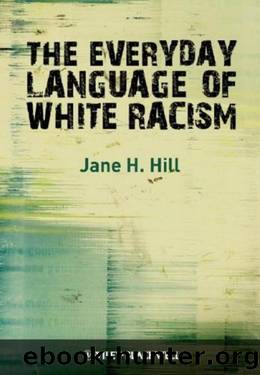The Everyday Language of White Racism by Hill Jane H

Author:Hill, Jane H. [Hill, Jane H.]
Language: eng
Format: epub
Tags: Language Arts & Disciplines, linguistics, Historical & Comparative, Sociolinguistics, Social Science, Anthropology, Cultural & Social
ISBN: 9781405184533
Google: VDIqAQAAIAAJ
Amazon: 1405184531
Publisher: Wiley
Published: 2008-10-20T00:00:00+00:00
b. âMr. Lott made matters only worse by embarking on a last-ditch campaign full of abject apologies that rang hollow to most witnessesâ
(Mr. Lott Steps Down 2002 [editorial]).
c. âAll the evidence indicates that what Lott truly meant to say was nothing â nothing at all . . . Critics and alarmists have taken Lottâs empty and meaningless words at a public event and injected them with substance they never hadâ (Rogers 2002).
Light talk, public and private: What light talk reveals about speaker beliefs
A second line of evidence used to explore the link between Lottâs words and his beliefs and intentions was the context for his remark. In the review of joking and parody above, we have seen that personalist ideology includes the possibility that some contexts permit disengagement between belief and the plain meaning of words. Journalism about Lottâs remark consistently contrasted private âlight talkâ with public âserious talk.â Public talk is thought to require a certain level of âseriousness,â while private talk can be âlight,â of no relevance in the formation of opinion.
Light talk among intimates provides an opportunity for White Americans to indulge in explicit ârace talkâ (Eliasoph 1999; Myers 2005; Picca and Feagin 2007), including epithets and stereotypes. To the degree that a particular stretch of talk is keyed as âlight,â it is relatively opaque to criticism and censure as racist. This opacity derives from cultural models that associate style, person, and space in simplistic default confi gurations. Light talk and joking are prototypically private, associated with the spaces of intimacy, where interpersonal solidarity is more important than strict adher-ence to truth. Indeed, the assumption of a key of âlightnessâ actually constitutes intimacy, so to reject the content of such talk is to reject the intimacy itself, and thus to threaten important social ties (Eliasoph 1999).
Light talk and joking are prototypically vernacular, so they are associated with private persons. While, as we saw in Chapter 3, evidence of âbiasâ
Gaffes: Racist Talk without Racists 109
is grounds for dismissing the views of a public speaker, bias and interest in private space are unproblematic. âIn private,â among intimates, a speaker need not claim neutrality or innocence, but may express her strongest and most authentic opinions. Thus to censure offensive talk in the light style/
private space/intimate relationship context is to attack, not interest, but character or judgment, a dangerous threat against the speaker (Hill 2001:92).
This kind of intimate talk can, in fact, be used âin public.â But such a usage constitutes a metaphorical code switch (Blom and Gumperz 1972) that layers a frame of privacy and intimacy into the interstices of a larger public context. This frame insulates the speaker from many kinds of challenges that might be made of public, serious talk.
This contrast between âpublicâ and âprivateâ appeared frequently in the discourse of the Lott debate. Many commentators argued that his remarks were prototypical âlight talkâ â in Lottâs own words, âfl attery to an old man on his birthdayâ â and that it was absurd to take them seriously or to seek in them some deeper meaning.
Download
This site does not store any files on its server. We only index and link to content provided by other sites. Please contact the content providers to delete copyright contents if any and email us, we'll remove relevant links or contents immediately.
Cecilia; Or, Memoirs of an Heiress — Volume 1 by Fanny Burney(31348)
Cecilia; Or, Memoirs of an Heiress — Volume 3 by Fanny Burney(30947)
Cecilia; Or, Memoirs of an Heiress — Volume 2 by Fanny Burney(30906)
The Lost Art of Listening by Michael P. Nichols(6481)
We Need to Talk by Celeste Headlee(4879)
Asking the Right Questions: A Guide to Critical Thinking by M. Neil Browne & Stuart M. Keeley(4597)
On Writing A Memoir of the Craft by Stephen King(4221)
Dialogue by Robert McKee(3591)
I Have Something to Say: Mastering the Art of Public Speaking in an Age of Disconnection by John Bowe(3520)
Pre-Suasion: A Revolutionary Way to Influence and Persuade by Robert Cialdini(3422)
Elements of Style 2017 by Richard De A'Morelli(2945)
The Book of Human Emotions by Tiffany Watt Smith(2777)
Good Humor, Bad Taste: A Sociology of the Joke by Kuipers Giselinde(2559)
Name Book, The: Over 10,000 Names--Their Meanings, Origins, and Spiritual Significance by Astoria Dorothy(2495)
Fluent Forever: How to Learn Any Language Fast and Never Forget It by Gabriel Wyner(2450)
The Grammaring Guide to English Grammar with Exercises by Péter Simon(2397)
Why I Write by George Orwell(2362)
The Art Of Deception by Kevin Mitnick(2301)
Don't Sleep, There Are Snakes by Daniel L. Everett(2220)
